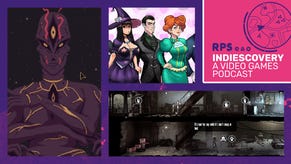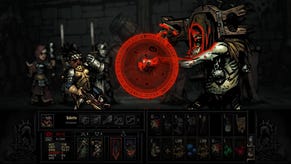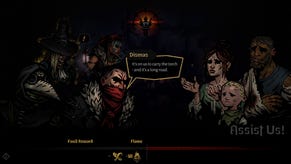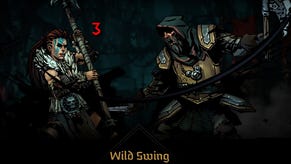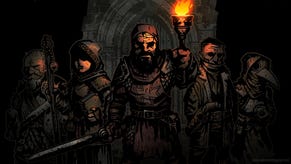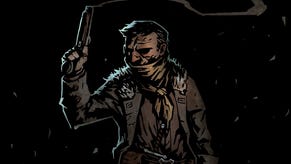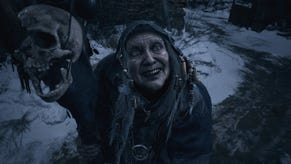How Darkest Dungeon found new horror through its turn-based combat
New perspectives
This is The Mechanic, where Alex Wiltshire invites developers to discuss the inner workings of their games. This time, Darkest Dungeon [official site].
Darkest Dungeon is an RPG in which four flawed heroes face damnably transcendent terrors as they explore the ancient narrow passages beneath a cursed mansion. Notch by notch, their grasp on sanity slips and their vitality trickles thinner as their torch dims and new horror befalls them.
This is a game in which pressure mounts, misfortune crushes, and mistakes are punished. You can’t expect your party to always survive, whether driven to death or madness, and its turn-based combat plays out with the constant understanding that every decision can turn on a knife-edge: a missed hit, an ill-considered target, the wrong ability. And a lot of that tension is founded on something that on its face sounds prosaic, even old-fashioned:
THE MECHANIC: 2D combat
The decision developer Red Hook Studios made to view your party of miscreants from the side powers a great deal of Darkest Dungeon’s atmosphere. It even defined how its distinctive take on combat would work. How it came about is down to many things: the practicalities of indie production, of the wish to develop bonds between players and their heroes, of breaking conventions, and of finding new ideas in a genre that’d surely long been plundered.
After all, the kind of RPGs studio co-founders Tyler Sigman and Chris Bourassa were originally looking to are as old as the hills. The Bard’s Tale, Eye of the Beholder, Ultima; games which array their parties of heroes out, sometimes in lines, against their enemies in combat.
“We had this idea for Darkest Dungeon which would be about the real downsides of being an adventurer, really,” Sigman tells me. At this early point, he and Bourassa had yet to found Red Hook Studios and were casting around for a project on which they could work together. They started to sketch out a tile-based game in which the party would move as a gaggle through a dungeon with transitions as they went into combat into a new view.
“Chris was saying a lot that resonated with me,” says Sigman. “You get tired of looking at people’s heads and it’s hard to bond with them, so he came up with this idea of side-on, and then you really get to see them well.”
“We knew we wanted to get down and close to the characters and show them off a little bit,” says Bourassa, who led Darkest Dungeon’s art. And he certainly capitalised on that. Darkest Dungeon’s heroes and enemies are large, detailed and extremely characterful, all the better for showcasing his striking thick-lined art style. They stick in the mind; you get attached to their all too commonly short lives and share some of their dread of their monstrous foes, since up close they seem so vulnerable.
“It led us down a bit of a rabbit hole as far as presentation goes,” says Bourassa. But, as the game’s lone artist for much of its development, it also had to be something that he could make on his own. Having a top-down view that transitioned to a side-on one for combat would significantly increase his workload.
“I like looking at the same character the whole time,” Bourassa says. “I don’t particularly enjoy switching modes with a big fade-to-black and then you’re looking at something completely different. But we thought we had to do that for a while! We thought that’s how you make RPGs, because it’s what’s understood to be the way to deliver a turn-based RPG.”
So they broke the rules, maintaining the same view for both dungeon-crawling and combat. While that decision was driven by the need for tight budgeting, it also provides Darkest Dungeon with a great deal of its personality: gritty, intimate, dangerous, claustrophobic. A game in which walking and battling come hand-in-hand and you’re always kept down on your heroes’ level.
As Bourassa and Sigman discussed what it’d mean for the combat design and what it meant for a line of heroes to face a line of monsters, they began to imagine a hero reaching with a spear deep into the ranks of the enemies. With that came the concept of positioning: where the place a hero or monster stood in the ranks could affect its ability to act.
Sigman remembered The Bard’s Tale and how heroes would be divided into two ranks. Those in the front one could hit with melee weapons, while those in the back could only hit with ranged or magical attacks. “So that was a mental model that we could start building on,” he says. “And it makes sense. You know you want your tank up front and stuff like that. I think we were pleasantly surprised as we started diving into that that there was a fair amount more we could do with this four-on-four than, say, those other games had done.”
“It makes logical sense too, right?” says Bourassa. “You couldn’t hit somebody all the way behind three other guys with a sword. So it’s easy for people to understand what we’re trying to simulate when they sit down and look at it. It makes that immediate logical sense.”
Positioning created a new and broad palette of actions and attributes which in turn led to interesting situations that you spend combat solving. If a monster pulls a hero out of its optimal position, where it’s exposed to minimal risk and from where its attacks are best used, what do you do? Spend its turn getting back into place? Spend another hero’s turn moving them instead to shuffle the positions around?
Positioning also opened up a new stat, move resistance, a value which determines how easy it is to pull a hero or monster out of place, and that led to trinkets and buffs which can boost this stat and debuffs which can decrease it.
And heroes and monsters could have a new attribute, movement, which defines how many positions in the rank they can shift in a single turn. “It influences your party design,” says Sigman. “If you want to be a min-maxer about parties with optimal positions, you’ll be very fragile compared to a versatile party.” In Darkest Dungeon, versatility is all about dealing with terrible circumstance: remaining effective even if the party’s been reshuffled or it has lost a hero.
On an aesthetic level, movement and positioning gives the hero classes different feels, whether agile or lumbering. But as much as they’re constructed from abilities and stats, Red Hook began designing them from a more thematic point of view. Their first step was to make a list of classes they liked the notion of and felt would fit in with the occult Victoriana setting. Having come up with 40, they then imagined what each would do. More often than not, they allowed this to determine their role and abilities in the game.
For example, among the 15 classes in the final release there’s the Leper, an exceedingly tough hero because his nerves are destroyed and he can’t feel pain, but his eyesight’s been ruined by his disease so he’s inaccurate. A tank fighter, then, prime for the front line.
Sometimes the concept of a character found its place in a role that was open in the roster, like the Grave Robber. Bourassa loved the visuals she inspired and the team saw her fitting into a glass cannon role: a tricksy character, highly accurate and with a high crit-rate, able to move two positions in the ranks and to attack both at range and in melee.
Sometimes a hero started in one place and then organically settled into another, like the Bounty Hunter. He could’ve been a tank, but as they explored him they realised he should be versatile, as happy setting snares and pulling monsters out of their formation as going toe-to-toe.
“Some of the classes are maybe more archetypal so it’s clear what they are, but some of them are kind of from the left field and we let them define what they needed to be,” says Sigman. And they built flexibility into each so as they levelled up they could fulfil different roles if the players trained them that way, allowing lots of experimentation with party compositions. “We didn’t really plan out party comps, we tried to make interesting heroes,” Sigman continues. “If you look at the whole game, if you make a bunch of interesting systems, hopefully they’ll all start working together well. We released all these heroes and watched what parties people built with them.”
Red Hook approached monster design in a similar way, since in most cases they can do anything heroes can. “We wanted to expose the full range of tools to both factions because it can create so many more interesting problems to solve,” says Bourassa. So, again, considering positioning was vital, such as with the Bone Arbalist, a ranged skeleton which deals damage from the monsters’ back ranks. “They’re terrifying, they can get a crit on you and do a lot of damage,” says Sigman. “Do I hook it and pull it forward? By contrast you have the little fish warriors in the Cove who have harpoons and are good in any rank, so it’s a different problem. Is my focus on eliminating them, or taking out this tank that’s guarding them? That texture is what we wanted to set up.”
Right now, Red Hook are finishing Darkest Dungeon’s first DLC, The Crimson Court. They set out wondering if they’d already wrung its combat system dry. “There’s a little concern, ‘Oh God, do we have to reuse every mechanic we have or are there more?’” says Sigman. “And we were able to find even more. It’s been a system that every time we go back to the well we’re able to pluck something out.” Red Hook discovered that adding a new twist on an antediluvian system opened up a dark and fascinating a new dimension for RPG play.










